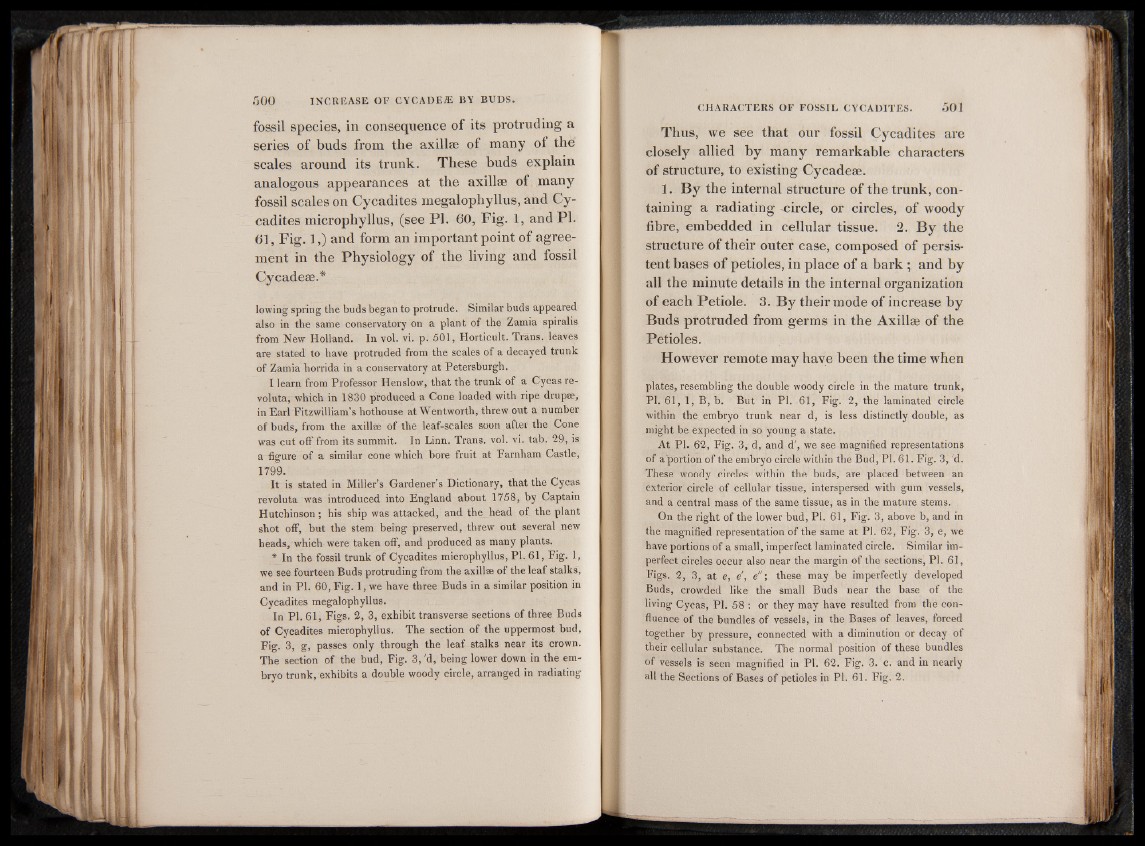
fossil species, in consequence of its protruding a
series of buds from the axillae of many of the
scales around its trunk. These buds explain
analogous appearances at the axillae of many
fossil scales on Cycadites megalophyllus, and Cy-
cadites mierophyllus, (see PI. 60, Fig. 1, and PI.
61, Fig. 1,) and form an important point of agreement
in the Physiology of the living and fossil
Cycadeae.*
lowing spring the buds began to protrude. Similar buds appeared
also in the same conservatory on a plant of the Zamia spiralis
from New Holland. In vol. vi. p. 501, Horticult. Trans, leaves
are stated to have protruded from the scales of a decayed trunk
of Zamia horrida in a conservatory at Petersburgh.
I learn from Professor Henslow, that the trunk of a Cycas re-
voluta, which in 1830 produced a Cone loaded with ripe drupse,
in Earl Fitzwilliam’s hothouse at Wentworth, threw out a number
of buds, from the axillae of the leaf-scales soon after the Cone
was cut off from its summit. In Linn. Trans, vol. vi. tab. 29, is
a figure of a similar cone which bore fruit at Farnham Castle,
1799.
It is stated in Miller’s Gardener’s Dictionary, that the Cycas
revoluta was introduced into England about 1758, by Captain
Hutchinson; his ship was attacked, and the head of the plant
shot off, but the stem being preserved, threw out several new
heads, which were taken off, and produced as many plants.
* In the fossil trunk of Cycadites mierophyllus, PI. 61, Fig. 1,
we see fourteen Buds protruding from the axillae of the leaf stalks,
and in PI. 60, Fig. 1, we have three Buds in a similar position in
Cycadites megalophyllus.
In PI. 61, Figs. 2, 3, exhibit transverse sections of three Buds
of Cycadites mierophyllus. The section of the uppermost bud,
Fig. 3, g, passes only through the leaf stalks near its crown.
The section of the bud, Fig. 3, 'd, being lower down in the embryo
trunk, exhibits a double woody circle, arranged in radiating
CHARACTERS OF FOSSIL CYCADITES. 501
Thus, we see that our fossil Cycadites are
closely allied by many remarkable characters
of structure, to existing Cycadeae.
1. By the internal structure of the trunk, containing
a radiating ^circle, or circles, of woody
fibre, embedded in cellular tissue. 2. By the
structure of their outer case, composed of persistent
bases of petioles, in place of a bark ; and by
all the minute details in the internal organization
of each Petiole. 3. By their mode of increase by
Buds protruded from germs in the Axillae of the
Petioles.
However remote may have been the time when
plates, resembling the double woody circle in the mature trunk,
PI. 61, 1, B, b. But in PI. 61, Fig. 2, the laminated circle
within the embryo trunk near d, is less distinctly double, as
might be expected in so young a state.
At PI. 62, Fig. 3, d, and d', we see magnified representations
of a portion of the embryo circle within the Bud, PI. 61. Fig. 3, 'd.
These woody circles within the buds, are placed between an
exterior circle of cellular tissue, interspersed with gum vessels,
and a central mass of the same tissue, as in the mature stems.
On the right of the lower bud, PI. 61, Fig. 3, above b, and in
the magnified representation of the same at PI. 62, Fig. 3, e, we
have portions of a small, imperfect laminated circle. Similar imperfect
circles occur also near the margin of the sections, PI. 61,
Figs. 2, 3, at e, e , e"; these may be imperfectly developed
Buds, crowded like the small Buds near the base of the
living Cycas, PI. 58 : or they may have resulted from the confluence
of the bundles of vessels, in the Bases of leaves, forced
together by pressure, connected with a diminution or decay of
their cellular substance. The normal position of these bundles
of vessels is seen magnified in PI. 62. Fig. 3. c. and in nearly
all the Sections of Bases of petioles in PI. 61. Fig. 2.